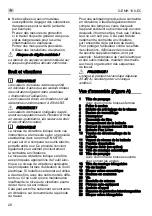
GE MH 18.0-EC
19
Kickback is the result of power tool misuse
and/or incorrect operating procedures or
conditions and can be avoided by taking
proper precautions as given below.
Maintain a firm grip on the power tool
and position your body and arm to allow
you to resist kickback forces.
Always use auxiliary handle, if provided,
for maximum control over kickback
or torque reaction during start-up.
The operator can control torque reac-
tions or kickback forces, if proper pre-
cautions are taken.
Never place your hand near the rotating
accessory. Accessory may kickback over
your hand.
Do not position your body in the area
where power tool will move if kickback
occurs. Kickback will propel the tool in
direction opposite to the wheel‘s
movement at the point of snagging.
Use special care when working corners,
sharp edges etc. Avoid bouncing and
snagging the accessory. Corners, sharp
edges or bouncing have a tendency to
snag the rotating accessory and cause
loss of control or kick-back.
Do not attach a saw chain woodcarving
blade or toothed saw blade. Such blades
create frequent kickback and loss of
control.
Special safety instructions for sanding:
Do not use excessively oversized
sanding disc paper. Follow manufac-
turers recommendations, when selecting
sanding paper. Larger sanding paper
extending beyond the sanding pad
presents a laceration hazard and may
cause snagging, tearing of the disc or
kickback.
Additional safety instructions
Use only extension cables permitted
for outdoor use.
It is not recommended to sand lead paint.
Lead paint should be removed
by a specialist only.
If plaster board or plaster is sanded,
this may cause static electricity to build
up on the tool. To ensure your safety,
the wall sander is earthed.
Remove dust with an earthed dust
extractor only.
Do not work on materials which release
hazardous substances (e.g. asbestos).
Take precautions if hazardous, combus-
tible or explosive dust is likely to occur.
Wear protective dust mask.
Use dust extraction system.
Damage to property!
The mains voltage and the voltage speci-
fications on the rating plate must correspond.
Noise and vibration
NOTE
Values for the A-weighted sound pressure
level and for the total vibration values can be
found in the “Instructions for use” table.
The noise and vibration values have been
determined in accordance with EN 60745.
CAUTION!
The indicated measurements refer to new
power tools. Daily use causes the noise and
vibration values to change.
NOTE
The vibration emission level given in this
information sheet has been measured
in accordance with a standardised test
given in EN 60745 and may be used
to compare one tool with another.
It may be used for a preliminary assessment
of exposure. The declared vibration emis-
sion level represents the main applications
of the tool. However if the tool is used
for different applications, with different
accessories or poorly maintained,
the vibration emission may differ.
This may significantly increase the expo-
sure level over the total working period.
However if the tool is used for different
applications, with different accessories
or poorly maintained, the vibration emission
may differ. This may significantly decrease
the exposure level over the total working
Summary of Contents for GE MH 18.0-EC
Page 1: ...GE MH 18 0 EC ...
Page 3: ...3 GE MH 18 0 EC ...
Page 4: ...4 GE MH 18 0 EC ...
Page 5: ...5 GE MH 18 0 EC ...
Page 6: ...6 GE MH 18 0 EC ...
Page 222: ...222 GE MH 18 0 EC FLEX N O V ...
Page 223: ...223 GE MH 18 0 EC FLEX H 1 2 M 1 2 3 4 5 6 7 8 9 ...
Page 225: ...225 GE MH 18 0 EC EN60745 EN 60745 85 ...
Page 226: ...226 GE MH 18 0 EC ...
Page 227: ...227 GE MH 18 0 EC 221 GE MH 18 0 EC FLEX 1900 GE MH 18 0 EC M ...
Page 228: ...504 661 03 2021 Für Druckfehler keine Gewähr Technische Änderungen vorbehalten ...
















































